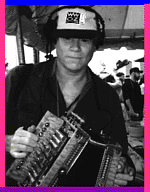

WWOZ’s 24-hour New Orleans gumbo
Earthy and diverse, it's 'the most important radio in town'Originally published in Current, Dec. 18, 1995
By Steve Behrens''I describe it something like a big bowl of gumbo, because it's all types,'' says Belle Moore, who goes by the name Brown Sugar on her blues program every Friday midnight.
She could be talking about New Orleans itself, but she means WWOZ-FM, the 15-year-old community radio outlet that a Times-Picayune guide called ''the most important radio station in New Orleans.''
Blues Access magazine advises visitors to New Orleans to tune in WWOZ and stay with it. ''This is, bar none, the only radio station you will ever need. It should be bottled and exported to needy communities. ... Sure, the deejays sometimes have trouble getting the discs cued up, and their raps and interviews sometimes border on the hallucinatory, but they also play the highest concentration of flat out great music known to man, and no commercials.''
Its 50,000 weekly listeners like WWOZ the way it is, totally plugged into the city's hometown music scene, a gumbo of blues, jazz, R&B and whatever.
Musicians are interviewed on air twice a day, on average, says General Manager David Freedman. Some show up unannounced, bearing their new recordings. Dr. John does a concert for the station this month, as do other local stars. At Mardi Gras, 'OZ volunteers joined in the Zulu Parade, tossing gold-painted coconuts off their truck. And in the spring, 'OZ aired more than 100 hours of live music from the jazz festival run by the New Orleans Jazz and Heritage Foundation, the station's licensee.
The station is diverse and earthy like its city, says music writer Geraldine Wyckoff. ''The heart and soul of New Orleans is funky, and the station reflects that.'' Its former location was above the legendary music club Tipitina's.
''You walked through the alley, past the trash cans and up the steps,'' remembers Kalamu ya Salaam, an ad man and poet who hosts a Thursday-night eclectic show. ''We would do live broadcasts by letting a mike down through a hole in the floor.''
The music today is still as funky, but WWOZ now captures it with the latest technology. Freedman loves the ''very fat, sweet sound'' they get for live remote broadcasts using pairs of 128 kb/sec ISDN lines. The station does several live remotes a month from local clubs, using five digital lines paid for by the clubs.
'OZ has its music out on a series of compact discs, as well as RealAudio files on its World Wide Web site. This year it syndicated its Mardi Gras and jazz fest programs to a combined 100 public radio stations, says Virginia Prescott, former operations chief.
But this does not mean WWOZ is about to become a homogenized public radio station. Though it got a satellite downlink three months ago, ''all we're taking is homeboys,'' says Freedman. That is, shows starring sons of New Orleans like Wynton and Branford Marsalis.
Some 80 volunteers rule their own shows on 'OZ.
''The music is segmented by loose categories, but within the categories the individual deejays do what they want to do,'' says Ya Salaam. ''There's no programming list you have to adhere to.'' He wouldn't do radio any other way. One of his recent shows had ''Brazilian music, fund, rap and spoken word, all within two hours, with live performance in the studio.''
Another deejay, Reddy Teddy, brings back forgotten R&B artists, and has been known to walk on his hands. ''Some people might say he talks too much on the radio,'' says a listener. ''He's a very enthusiastic person, let's put it that way. He's revved up about music.''
Betty Rankin (''Big Mama'') hosts the 8:30 a.m. Saturday show with traditional jazz, straying into Mahalia Jackson on Easter. ''It tickles the life out of me'' when a stranger occasionally recognizes her voice from the radio, she says. ''For years I had been somebody's wife and somebody's mother. Now my sons get, 'Are you Big Mama's son?' ''
After Rankin's show comes Sean O'Meara's The Irish Show, and many of her jazz fans most likely tune out.
Both are great shows, says Prescott, but ''you can almost hear the dials clicking off'' between them. Without a program director to manage the schedule, producers guard their turf. ''The culture of the station was about hanging on to the way it is.''
When consultants from the CPB-funded Blueprint Project came to help the financially strapped station in the early '90s, ''the reaction was horrible,'' remembers Prescott.
But the station came away with stronger finances and a somewhat more coherent schedule. Since Freedman arrived in 1992, after the Blueprint Project had begun, WWOZ's weekly cume audience is up from 40,000 to 50,000 and its cash revenues up from $250,000 to about $500,000 a year. The consultants also got the station to add morning weather and traffic reports, says Freedman. ''It was just some radio basics, but they were the guys who did it.''
Freedman himself has been part of the solution, bringing relative stability after a rocky period with many short-term, controversial managers.
''All I can say is we've hit on a combination that works--David Freedman, mostly,'' says Big Mama Betty Rankin.

Trumpeter James Andrews and the Trombone Shorty Brass Band start out from the river for WWOZ's annual Mardi Gras party.

David Freedman in the station's tent at Jazz Fest

Outside link: WWOZ's web site, with online audio.
Web page created Jan. 3, 1996
Revised Sept. 23, 1997
Current
The newspaper about public television and radio
in the United States
A service of Current Publishing Committee, Takoma Park, Md.
E-mail: webcurrent.org
301-270-7240
Copyright 1997